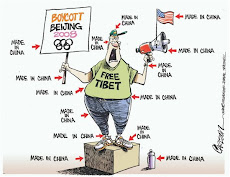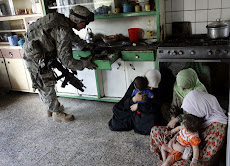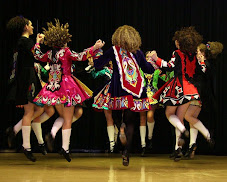 A child walking in a trash-strewn lot near the gated community of Hamilton Court in Gurgaon, India. (Ruth Fremson/The New York Times)
A child walking in a trash-strewn lot near the gated community of Hamilton Court in Gurgaon, India. (Ruth Fremson/The New York Times) GURGAON, India: June 9th. (NY Times) — When the scorch of summer hit this north Indian boomtown, and the municipal water supply worked only a few hours each day, inside a high-rise tower called Hamilton Court, Jaya Chand could turn on her kitchen tap around the clock, and water would gush out. The same was true when the electricity went out in the city, which it did on average for 12 hours a day, something that once prompted residents elsewhere in Gurgaon to storm the local power office. All the while, the Chands’ flat screen television glowed, the air-conditioners hummed, and the elevators cruised up and down Hamilton Court’s 25 floors. Hamilton Court — complete with a private school within its gates, groomed lawns and security guards — is just one of the exclusive gated communities that have blossomed across India in recent years. At least for the newly moneyed upper middle class, they offer at high prices what the government cannot, at least not to the liking of their residents. These enclaves have emerged on the outskirts of prospering, overburdened cities, from this frontier town next to the capital to the edges of seam-splitting Bangalore. They allow their residents to buy their way out of the hardships that afflict vast multitudes in this country of more than one billion. And they reflect the desires of India’s small but growing ranks of wealthy professionals, giving them Western amenities along with Indian indulgences: an army of maids and chauffeurs live in a vast shantytown across the street. “A kind of self-contained island” is how Mrs. Chand’s husband, Ashish, describes Hamilton Court.
India has always had its upper classes, as well as legions of the world’s very poor. But today a landscape dotted with Hamilton Courts, pressed up against the slums that serve them, has underscored more than ever the stark gulf between those worlds, raising uncomfortable questions for a democratically elected government about whether India can enable all its citizens to scale the golden ladders of the new economy. “Things have gotten better for the lucky class,” Mrs. Chand, 36, said one day, as she fixed lunch in full view of Chakkarpur, the shantytown where one of her two maids, Shefali Das, lives. “Otherwise, it is still a fight.” When the power goes out, the lights of Hamilton Court bathe Chakkarpur in a dusky glow. Under the open sky, across the street from the tower, Mrs. Das’s sons take cold bucket baths each day. The slum is as much a product of the new India as Hamilton Court, the opportunities of this new city drawing hundreds of thousands from the hungry hinterlands.
In China, the main Asian competitor to which India is often compared, the state managed early on to harness economic expansion for huge public works projects and then allow more and more Chinese to partake of the benefits. There, the poor are far less likely to be deprived of basic services, whether clean water or basic schooling. In India, poverty has also dropped appreciably in the last 17 years of economic change, even as the gulf between the rich and poor has grown. More than a quarter of all Indians still live below the official poverty line (subsisting on roughly $1 a day); one in four city dwellers live on less than 50 cents a day; and nearly half of all Indian children are clinically malnourished.
At the same time, the ranks of dollar millionaires have swelled to 100,000, and the Indian middle class, though notoriously hard to define and still small, has by all indications expanded. For those with the right skills, the good times have been very good. Mr. Chand, 34, a business school graduate who runs the regional operations for an American manufacturing firm, has seen his salary grow eightfold in the last five years, which is not unusual for upper class Indians like him. The Chands are typical of Hamilton Court residents: Well-traveled young professionals, some returnees to India after years abroad, grateful for the conveniences. Some of them are also the first in their families to live so comfortably.
Mr. Chand attended an elite but government-financed school. His father was in the military. Mrs. Chand’s father was a civil servant; her mother, a teacher. Some of their expenses, Mr. Chand said, their elders consider lavish. Gurgaon, a largely privately developed city and a metonym for Indian ambition, has seen a building frenzy to satisfy people like the Chands. The city’s population has nearly doubled in the last six years, to 1.5 million. The skyline is dotted with scaffolds. Glass towers house companies like American Express and Accenture. Not far from Hamilton Court, Burberry and have set up shop. State services, meanwhile, have barely kept pace. The city has neither enough water nor electricity for the population. There is no sewage treatment plant yet; construction is scheduled to begin this year. India has long lived with such inequities, and though a Maoist rebellion is building in the countryside, the nation has for the most part skirted social upheaval through a critical safety valve: giving the poor their chance to vent at the ballot box. Indeed, four years ago, voters threw out the incumbent government, with its “India Shining” slogan, because it was perceived to have neglected the poor. It is little wonder then that the current administration has seized on “inclusive growth” as its mantra, and as elections approach in less than a year, it is spending heavily on education, widely acknowledged as a key barrier to upward mobility for the poor.
That the bottom of the pyramid votes became obvious to the Chands when they last went to the polls. “I didn’t see too many people like us,” Mr. Chand recalled. Hamilton Court, meanwhile, is rarely courted at election time. Inside its gates, the Chands have everything they might need: the coveted Sri Ram School, a private health clinic and clubhouse next door, security guards to keep out unwanted strangers and well-groomed lawns and paths for power walks and cricket games. “Women and children are not encouraged to go outside,” said Madan Mohan Bhalla, president of the Hamilton Court Resident Welfare Association. “If they want to have a walk, they can walk inside. It’s a different world outside the gate.” For the Chands, the school was one of the building’s main draws. They bought their apartment just after the birth of their eldest, Aditya, who is now in first grade. Next year, they hope to enroll their youngest, Madhav. The school recently hosted a classical music concert. The business school guru C.K. Prahalad gave a lecture the following week. Mr. Chand called Hamilton Court a community of “like-minded people.”
Some 600 domestic staff members work at Hamilton Court, an average of 2.26 per apartment. The building employs its own plumbers and electricians. At any one time, 22 security guards and 32 surveillance cameras are at work. “We can’t rely on the police,” Mr. Bhalla said. Gurgaon has one policeman for every 1,000 residents — lower than the national average — and a surfeit of what Mr. Bhalla calls official apathy. “We have to save ourselves,” he said. The guards at the gate are instructed not to let nannies take children outside, and men delivering pizza or okra are allowed in only with permission. Once, Mr. Bhalla recalled proudly, a servant caught spitting on the lawn was beaten up by the building staff. Recently, Mr. Bhalla’s association cut a path from the main gate to the private club next door, so residents no longer have to share the public sidewalk with servants and the occasional cow.
The Gurgaon police chief, Mohinder Lal, said the city’s new residents had unrealistic expectations of the Indian police. If a police officer does not arrive quickly, Mr. Lal rued, the residents complain. “They say, ‘You’re late. Come back tomorrow.’ ” He, too, said that the police could not cope with the disorder of Gurgaon’s growth. “Development comes, mess comes, then police come and infrastructure,” he said. Gurgaon’s security guards, most of whom live in Mrs. Das’s slum, likewise have little love for law enforcement. They accuse the police of raiding their shanty, hauling men to the local stations and forcing them to clean and cook before releasing them back to their hovels, often without a single charge. The police say migrant workers are a source of crime.
One afternoon, Mrs. Das returned from her duties at Hamilton Court, cleaned up the lunch plates that her sons had left on the floor and took her plastic water jugs to stand in line under the acacia tree, only to discover that there was a power failure, which meant the water pump could not be turned on. Next to the water line, workers were ironing a pile of orange janitors’ uniforms from a neighborhood mall; the laundry service is one of Chakkarpur’s many thriving private enterprises. Mrs. Das already had two of her sons in a charity-run school nearby, but much to her shame, she missed the registration deadline for her youngest, now 6, who will now be a year behind his peers. Her biggest regret is being unable to check her sons’ homework. Mrs. Das has worked in other people’s homes since she was 7. She cannot read. “If they are educated,” she said of her boys, “at least they can do something when they grow up.” Next door to Mrs. Das’s brick-and-tin room, a 2-year-old lay on a cot outside, flies dancing on his face. His mother, Sunita, 18, said the child had not been immunized because she had no idea where to take him, and no public health workers had come, as they are supposed to. The baby is weak, Sunita reckoned, because she cannot produce breast milk. During repeated visits in recent months, a government-financed childhood nutrition center was closed. The nearest government hospital was empty. Mrs. Chand, a doctor who decided to stay home to raise her children, trained in a government hospital. Her other maid told her recently that her own daughter had given birth at home, down there in the slum. Sometimes, Mrs. Chand said, she thinks of opening a clinic there. But she also said she understood that there was little that she, or anyone, could do. “Two worlds,” she observed, “just across the street.”
By Somini Sengupta
+++++++++++++++++++++++++++++++++++++++++++++++++++
Disclaimer
No responsibility or liability shall attach itself to either myself or to the blogspot ‘Mozlink’ for any or all of the articles/images placed here. The placing of an article does not necessarily imply that I agree or accept the contents of the article as being necessarily factual in theology, dogma or otherwise.
Mozlink





















































No comments:
Post a Comment